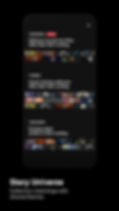From "Manhwa" to Drama: Drawings Come to Life
- GwenchaNoonas
- Apr 15, 2021
- 9 min read
Updated: Apr 30, 2024
Cartoons have been a popular form of human expression, to evoke humor or make a political statement, better captured by an image or a series of images. This popularity makes them a goldmine for censors, activists, and artists alike.
It’s not surprising that k-dramas would draw inspiration from illustrated storytelling as an art form. The beautiful and vibrant images on print and on the web can be translated effectively into the language of the small screen. In this article, we take a deep dive into the fascinating connection between the 2D and 3D worlds in KD(ramaland).

The Korean term "manhwa" and the Japanese word "manga" originate from the Chinese "màn huà", meaning “impromptu sketches.” Manhwa refers to both print and digital comics, although the digital form of the manhwa is more commonly known as a “webtoon.” Some webtoons are derived from their text-based cousins, the “web novels."
Manhwa Origins
How has the manhwaga, the manhwa artist or author, been inspired throughout history?
During the Japanese occupation from 1910-1945, Japanese culture, including the manga, was assimilated into Korean society. Korean cartoons first appeared in print in 1910 and were similar to the modern-day editorial cartoon: single-paneled and political. Because they were popular and anti-Japanese, by the middle of the 1920s, political newspapers were closed down.
The newspaper cartoonists had no choice but to switch to humorous illustrations and children's drawings. The term manhwa was first used then. An early Korean cartoonist, Ahn Seokju, produced Manmun Manhwa, a satire published in the newspaper Chosun Ilbo.
Manhwa segye, a magazine solely for manhwa, was produced, as new genres such as romance, drama, and sports developed. In 1945, with the liberation from the Japanese, cartoons reemerged in print media. The Seoul Times published English cartoons by Kim Yong-hwan, a Korean cartoonist.

After the Republic of Korea (or South Korea) was established in 1948, Kim Yong-hwan founded the Manhwa Haengjin, the first Korean comic magazine. Unfortunately, the government soon shut it down because the cover was deemed inappropriate.
From the 1950s to the 1960s, the manhwa was used for the Korean War propaganda. In the 1960s, it became popular, grew in genre diversity, but attracted government censorship. The manhwabang or manhwa café emerged, providing private reading space for customers. Sunjeong manhwa attracted female readers while the myeongnyang or happy comics attracted those tired of serious themes. Western comics and pirated manga significantly influenced the manhwa.
South Korea ended its Japanese media ban in the 1990s, further influencing the modern manhwa aesthetics. The manga and the manhwa are also associated with a young readership, although there are multiple genres that cater to different age groups, including adults.
Webtoon: Stepping out of the Manga Shadow

While the manga has been more popular, the webtoon has been gaining advantage. The webtoon is published in color, optimized for reading from a mobile device, read from left to right, and under the radar of South Korean censorship. The change from the multi-page clicks (horizontal) to the infinite scroll (vertical) is a key innovation enabled by the mobile revolution.

After the country's economic collapse, many manhwa publishers were shut down in the late '90s and early 2000s. It seemed the industry was dying with the dearth of new content.
In 2002, South Korean web portal Daum launched the "World in Comics" section, a forerunner of the Daum Webtoon, which later became the most popular webtoon platform in 2003. The Hello Schoolgirl series by Kang Full (Kang Do-young) is the "first successful serialized webtoon that revolved around a single story."
Similarly seeing this crisis as an opportunity, Kim Jun-koo founded LINE Webtoon (or WEBTOON) in South Korea in 2004. By innovating through the infinite scroll, publishing daily for free, targeting teens, and providing a platform for creators, WEBTOON quickly became successful. It introduced an international website and mobile app in 2014 that "revolutionized how the comics world reads for entertainment." A year later, it adopted HTML5 in selected works to produce sound effects and motion while scrolling.
According to Kim Jun-koo, WEBTOON was "used in 60 countries and had 55 million monthly users. It was also averaging 100 billion annual views.” In 2020, Naver Webtoon Corp. started to manage WEBTOON. A year later, Naver acquired the social fan fiction platform Wattpad, gearing up in the global clamor for webtoons.
Although Daum merged with Kakao in 2014, it was only in 2021 when Daum Webtoon was relaunched into Kakao Webtoon, with new features such as AI-powered recommendations, related stories or drawing styles (story universe), and moving images as the cover image for selected works. Following a similar path as Naver's, Kakao Entertainment purchased American web novel platforms Tapas Media and Radish.
With this massive growth and the race to acquire k-content, it is not surprising that the manhwa is considered as a rich source of content for k-dramas, movies, and other art forms.
Transcending Other Art Forms: TV Series, Film, Musical, and Anime

Based on the 1844 novel The Count of Monte Cristo, Hwang Mi-na's revenge manhwa Goodbye Mr. Black was published in 1983, but was adapted into a TV series only in 2016. The romance thriller starred Lee Jin-wook and Moon Chae-won.
2004 Kakao (formerly Daum) webtoon Apartment by Kang Full was made into the 2006 horror film Apt., the first webtoon adapted into a movie.
The award-winning Kakao webtoon The Great Catsby by Doha Kang and Kim Seung-jin was made into a musical in 2006. The year after, it was produced as a rom-com series with MC Mong in the titular role.
Adapted from the Kakao webtoon of the same name, Secretly, Greatly by HUN is one of 2013's highest-grossing movies. Kim Soo-hyun played the North Korean spy in the dramedy action film.
Crunchyroll released the anime (Japanese animation) adaptations of Tower of God by Slave.In.Utero (Lee Jong-hui), The God of High School by Park Yong-je, and Noblesse by Son Jae-ho and Lee Gwang-su, all Naver webtoons, in 2020.
The k-drama adaptation of Lee Dong-gun's famous Naver webtoon Yumi's Cells is the first one to integrate both live action and 3D animation. Starring Kim Go-eun and Ahn Bo-hyun, the first season of the 2021 slice-of-life romantic drama was produced by Sidus Animation Studios.
The growing global clamor for k-content has evidently prompted a corresponding increase in demand for high-quality k-drama scripts. As a result, webtoons have become one of the sources for such content, so much so that a k-drama about webtoon creation and production (Today's Webtoon) was released in 2022. But perhaps the best evidence of webtoons becoming mainstream is that a manhwaga transitioned to scriptwriting himself. Kang Full successfully debuted as a scriptwriter in the Disney+ hit superhero series Moving, which was so popular that Disney+ Korea credits the k-drama for adding more than a million subscribers to the platform. This comes as no surprise as the multi-awarded webtoon artist is respected in his industry for his incredible talent in storytelling and that the cast and crew masterfully brought the superhero series to life. Will there be more manhwagas following Kang Full's lead?
Printed/OG Manhwa to K-Drama
What follows is a list of some popular k-dramas inspired by the printed manhwa.
Full House (2004)

Full House was published from 1993 to 1999, created by manhwaga Woon Soo-yeon. At that time, the protagonist Ellie Gee was considered refreshingly self-reliant, criticized even for being too blunt. Nevertheless, the manhwa has been so popular that a 25th-anniversary edition was published in 2021.
Its k-drama adaptation became one of the pillars of Hallyu as it achieved peak audience share of over 40%, pioneered rom-com as a genre, and spread fame across Asia.
An aspiring scriptwriter, the female lead renamed Han Ji-eun (Song Hye-kyo), lives in the "Full House" built by her deceased father. Without her knowledge, her best friends sell her house to a popular actor named Lee Young-jae (Rain). Ji-eun and Young-jae do not get along, but eventually, they agree to live together. Later, they enter into a contract marriage to make Young-jae's crush, Kang Hye-won (Han Eun-jung), jealous. Things take a different turn as Ji-eun and Young-jae fall in love with each other. Watch the k-drama from a 2000s lens, knowing it’s a product of its time.
Princess Hours (2006)

Goong (meaning "Palace") is a manhwa by author Park So-hee, set in present-day Korea with a monarchy that has survived since 1945.
Prompted by the serious illness of his father, Emperor Lee Hyeon, Crown Prince Lee Shin (Ju Ji-hoon) marries his classmate Chae-kyeong (Yoon Eun-hye). Chae-kyong is a commoner to whom Shin is betrothed by his grandfather, the late Emperor Seongjo, to honor an agreement with Chae-kyeong's grandfather.
Their married life is anything but peaceful. Lady Hwa-young, former Crown Princess, returns with her son, Lee Yul, to restore her son in the line of succession. Love lines entangle Yul with Chae-kyeong, and Shin with Hyo-rin, a ballerina whom Shin loved before his marriage. Most watchers suffered from the heart-breaking second-lead syndrome, so be prepared for this and other tropes.
Webtoon to K-Drama
Listed below are some hit k-dramas adapted from the digital manhwa.
Cheese in the Trap (2016)

The Naver webtoon Cheese in the Trap was already a longstanding hit since 2010, well before it was adapted for TV in 2016. The story centers on put-upon college student Hong Seol (Kim Go-eun) and her relationship with Yoo Jung (Park Hae-jin), a popular and model student whom she suspects to have a more duplicitous, darker side. The story also features siblings Baek In-ho (Seo Kang-joon) and Baek In-ha (Lee Sung-kyung) who tangle themselves into the couple’s lives. The story goes beyond romance and dives into the harsh reality of college life (and the injustices of group work) and what happens when you are confronted with people’s expectations of how you should behave. The webtoon offers a much better understanding of the characters’ development, particularly with Jung in later seasons. The drama version seems to have favored Baek In-ho’s backstory and internal monologues and this has significantly changed the dynamic of the story and turned it into a love-triangle narrative. The drama ending was also divisive among fans as it veered drastically from the original (though the webtoon was not yet finished by the time the drama aired). Nevertheless, both versions are worthy of attention, if only to empathize with Seol’s exasperation at always having to be the mature one. Same, Seol, same.
Mama Fairy and the Woodcutter (2018)

Based accurately and heavily on the whimsical Naver webtoon, Tale of the Gyeryong Fairy, Mama Fairy and the Woodcutter is a fun and lighthearted series with several surprising twists. The viewers follow Sun Ok-Nam (Moon Chae-won / Ko Du-shim), an earthbound fairy who has no way of getting back to the fairy realm. Her only chance? To wait for the reincarnation of her husband while running a café. Her patience finally pays off when two men walk in to her café. Who could her husband be? Could it be the prickly Professor Jung Ji-hyun (Yoon Hyun-min) or his gullible and sweet assistant, Kim Geum (Seo Ji-hoon)?
While not as popular as other webtoon adaptations, Mama Fairy and the Woodcutter’s beautiful cinematography and interesting storyline can definitely draw viewers in. Bonus: the main characters are wonderfully different from what we’re used to! I mean, where can you encounter a half-immortal tiger who writes boys' love (BL) web novels? Or a fairy god addicted to a Mobile Legend-like game? Or a love corner (not a triangle!) that looks like it’s two young men vying for the affection of a woman who looks old enough to be called a halmeoni (grandmother)? Yes, this series doesn’t skimp on the comedy at all! But don’t be fooled by all those funny scenes, Mama Fairy and the Woodcutter, like all fairy tales, wants to impart valuable lessons to people… and for this series? That lesson would have to revolve around anger and forgiveness. Curious about that? Well, you'll have to watch (or read) Mama Fairy and the Woodcutter to find out.
Extraordinary You (2019)

Based on the popular Kakao webtoon, July Found by Chance, Extraordinary You is a fun and unique k-drama that will have viewers laughing, as it makes fun of the most used tropes and stereotypes found in rom-com manhwas.
The stage is set when Eun Dan-oh (Kim Hye-yoon) enters the story. She’s pretty, rich, and popular with the boys. She takes being a manhwa character all in stride... until she realizes that she's not the main lead! In denial about the story the writer has planned for her, Dan-oh vows to change her fate with the help of another supporting character, Ha-ru (Rowoon). But along the way, Dan-oh and Ha-ru discover that their story does not begin and end in just one book. The chemistry between the leads and the meta-level humor definitely make this series an easy binge.
The Uncanny Counter Seasons 1 (2020) and 2 (2023)

Based on the Kakao webtoon Amazing Rumor by Jang Yi, The Uncanny Counter tells the story of So Mun (Jo Byeong-gyu). A high school boy who suffers from a leg injury, he is recruited to be a Counter. He meets the other Counters, Ga Mo-tak (Yoo Jun-sang), Do Ha-na (Kim Se-jeong), and Chu Mae-ok (Yeom Hye-ran). Together, they search for and combat evil spirits who escape from the afterlife.
According to Nielsen, the Season 1 final episode scored an average rating of 11% in Korea, making it the highest-rated drama of cable channel OCN.
Post-2020 K-drama Adaptations
As the popularity of Korean content becomes even more widespread, more webtoons are expected to become adapted into k-dramas. See our reviews of k-drama adaptations from 2021 onwards:
Bloodhounds (2023)
Chicken Nugget (2024)
Death's Game Parts 1 (2023) and 2 (2024)
D.P. Season 1 (2021)
D.P. Season 2 (2023)
Hellbound (2021)
How to Be Thirty (2021)
The Killing Vote (2023)
Marry My Husband (2024)
Moving (2023)
Perfect Marriage Revenge (2023)
Navillera (2021)
The Sound of Magic (2022)
Taxi Driver Season 1 (2021)
Taxi Driver Season 2 (2023)
Weak Hero Class 1 (2022)
Work Later, Drink Now Season 1 (2021)
Yumi's Cells Season 1 (2021)
References
Acuna, Kirsten. "Millions in Korea are obsessed with these revolutionary comics — now they're going global." Business Insider, 12 Feb. 2016, https://www.businessinsider.com/what-is-webtoons-2016-2.
Binimbol, Huann. “What Is Manhwa?” Manga Planet Blog, 24 Apr. 2020, https://mangaplanet.com/what-is-manhwa/.
"Daum Webtoon becomes Kakao Webtoon as competition intensifies." Korea JoongAng Daily, 20 July 2021, https://koreajoongangdaily.joins.com/2021/07/20/business/tech/Kakao-Webtoon-Daum-Webtoon-Kakao-Page/20210720175007618.html.
McKinney, DW. “Riding the Wave: The Steady Rise of Korean Manhwa.” Los Angeles Review of Books, 24 Oct. 2020, https://lareviewofbooks.org/article/riding-the-wave-the-steady-rise-of-korean-manhwa/.
Park, Ji-won. “[Interview] Comic Artist Won Soo-Yeon Talks about Reprint of 'Full House' Manhwa.” The Korea Times, 18 May 2021, https://www.koreatimes.co.kr/www/culture/2021/11/142_309034.html.
Petersen, Robert S. Comics, Manga, and Graphic Novels: A History of Graphic Narratives. ABC-CLIO, 2011.














